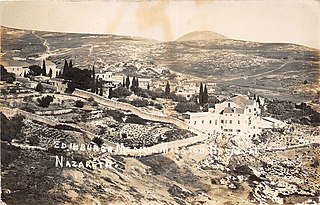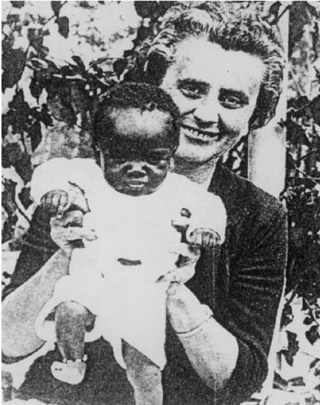United Society Partners in the Gospel (USPG) is a United Kingdom-based charitable organization.
The Duke University Health System combines the Duke University School of Medicine, the Duke University School of Nursing, the Duke Clinic, and the member hospitals into a system of research, clinical care, and education.

A hospital is a health care institution providing patient treatment with specialized health science and auxiliary healthcare staff and medical equipment. The best-known type of hospital is the general hospital, which typically has an emergency department to treat urgent health problems ranging from fire and accident victims to a sudden illness. A district hospital typically is the major health care facility in its region, with many beds for intensive care and additional beds for patients who need long-term care. Specialized hospitals include trauma centers, rehabilitation hospitals, children's hospitals, seniors' (geriatric) hospitals, and hospitals for dealing with specific medical needs such as psychiatric treatment and certain disease categories. Specialized hospitals can help reduce health care costs compared to general hospitals. Hospitals are classified as general, specialty, or government depending on the sources of income received.
Kalongo Hospital, also known as Dr. Ambrosoli Memorial Hospital, is a hospital in Northern Uganda. It is a private, community hospital, serving the town of Kalongo and surrounding areas of Agago District, Pader District and parts of Kitgum District.

The EMMS Nazareth Hospital, also known as Scottish Hospital and English Hospital, is the Christian community hospital in Nazareth, Israel. It was founded as a Christian mission by Dr. Kaloost Vartan and the Edinburgh Medical Missionary Society in 1861. The hospital now houses 147 beds, employs over 500 staff, and receives over 50,000 visits annually.
Ethel Margaret Phillips (1876–1951) was a British medical missionary who worked in China for approximately 43 years. Before becoming a medical missionary, Phillips gained admittance into the Victoria University of Manchester and subsequently became the third woman to graduate with a degree in medicine from the University. Upon graduating, Phillips was sent to China as a medical missionary by the Society for the Propagation of the Gospel (SPG). In China, Phillips faced some difficulty with the local population, as they did not trust foreigners after the political turmoil that had taken place recently before Phillips' arrival. Her accomplishments in China include the construction of two hospitals, work with the YWCA, and the establishment of a private practice. Phillips was interned in China during the Second World War. Phillips returned to the UK in 1948 and died three years later.
The Delhi Female Medical Mission (DFMM) was a medical mission in Delhi, India that was founded in the mid-19th century by an Indian-born Englishwoman named Priscilla Winter. The organization started as a dispensary along the Yamuna River in Delhi, but over time developed into a mission, which was then established as St. Stephen's Hospital for Women and Children, a hospital that remains in operation today.

Arthur Neve, MD (1859–1919) was a Christian medical missionary who felt the call to serve abroad early on in life. As a well distinguished doctor, Neve willingly left home at a young age when he was called to Kashmir to continue the medical missions of Dr. Theodore Maxwell and Dr. William Elmsie. He moved to Asia and never looked back, soon becoming the head of the Kashmir Medical Mission where he would go on to serve the sick in Kashmir for the next thirty four years by building the Kashmir Mission Hospital with his brother, Ernest. Influenced by his strong roots in his religion, Neve served the people of Kashmir while also spreading his Christian message to a predominantly Muslim and Brahmin area.
Dr David Duncan Main (1856-1934) was a British doctor, best known for his medical missionary work in Hangzhou, the capital of the south-eastern Chinese Province Zhejiang, during the late 1800s and early 1900s. He was superintendent of the Church Missionary Society (CMS) Medical Mission from his arrival in 1881 until 1927, and principal of the Hangzhou Medical Training College. He was also involved in the formation of the Young Men's Christian Association (YMCA) in Hangzhou, which focused on preaching the Gospel to non-Christians. Main and his wife, Florence Nightingale Smith, opened over thirty medical buildings during their time in China, as well as a centre for industrial work training.
Nyenga Mission Hospital, whose formal name is St. Francis Hospital Nyenga, but is commonly referred to as Nyenga Hospital, is a non-profit, community hospital in Uganda. It is owned and operated by the Roman Catholic Diocese of Lugazi.

Alice Marietta Marval popularly known as Dr Alice Marval of Cawnpore, was an English doctor and nurse who built a hospital in India to serve women and children who were excluded from conventional medical facilities in Cawnpore. She died after contracting the Plague.

Theresa "Teddy" Robinson Buck was an American-born Southern Rhodesian missionary. She trained as a nurse in the United States before being commissioned as a missionary to Southern Rhodesia in 1938. Buck worked in hospitals in Mount Selinda and Chikore, becoming sister-in-charge of both. After her death the Chikore hospital was renamed in her honour.

St Stephen's Hospital Delhi is one of the oldest and the largest private hospitals in New Delhi, India. The hospital today has 600 beds and is presently a superspeciality tertiary care hospital offering comprehensive care covering all major clinical specialities and most super-specialities. The institution started as a dispensary in 1876 by the Delhi Female Medical Mission, on the banks of river Yamuna. The hospital was later established in 1885 as a small facility with 50 beds in Chandni Chowk and opened by Lady Dufferin, Vicereine of India. It was the first hospital for women and children.

Johanna Decker was a Roman Catholic missionary doctor from West Germany who was murdered by "drunken terrorists" / "nationalist guerrillas" in Southern Rhodesia, during the Rhodesian Bush War.
Nora Neve (1873-1952) was a British nurse and medical missionary with the Church Missionary Society who pioneered missionary nursing. Her work was instrumental in the development of the Kashmir Mission Hospital in Srinagar. She was the hospital's first Superintendent of Nursing and led education and cleanliness initiatives. Neve also recorded and published records of Kashmiri hospital practices in the American Journal of Nursing, contributing to the tool kits of other missionaries and preserving a part of Kashmir's cultural history.
The Baptist Convention of Zimbabwe is a Baptist Christian denomination in Zimbabwe. It is affiliated with the Baptist World Alliance and the Evangelical Fellowship of Zimbabwe. The headquarters is in Gweru.

James Bennett McCord was an American medical missionary and physician who founded the McCord Zulu Hospital and spent over three decades treating mostly African, Native, and mixed race patients in Durban, South Africa. He pioneered the training program for the first African nurses, worked towards the establishment of a medical school dedicated to training black doctors, and shared his life story in his autobiography titled My Patients Were Zulus.
Walter Fisher was an English surgeon and missionary who worked in Zambia for over 40 years. Born in Greenwich, Fisher was raised in a large, middle-class home. A "Plym", Fisher used his faith as a foundation for his service to people. He completed his medical studies in Guy's Hospital and qualified as a surgeon in 1887.
The Central African Journal of Medicine is a quarterly peer-reviewed general medical journal that aims to advance medical education and research in Africa. The focus is on broad medical themes, which reflect prevalent and significant conditions in the area. It was founded in 1953 by Michael Gelfand and Joseph Ritchken. The publisher is the University of Zimbabwe Publications As of February 2023, over 4000 articles have been published in this journal.







